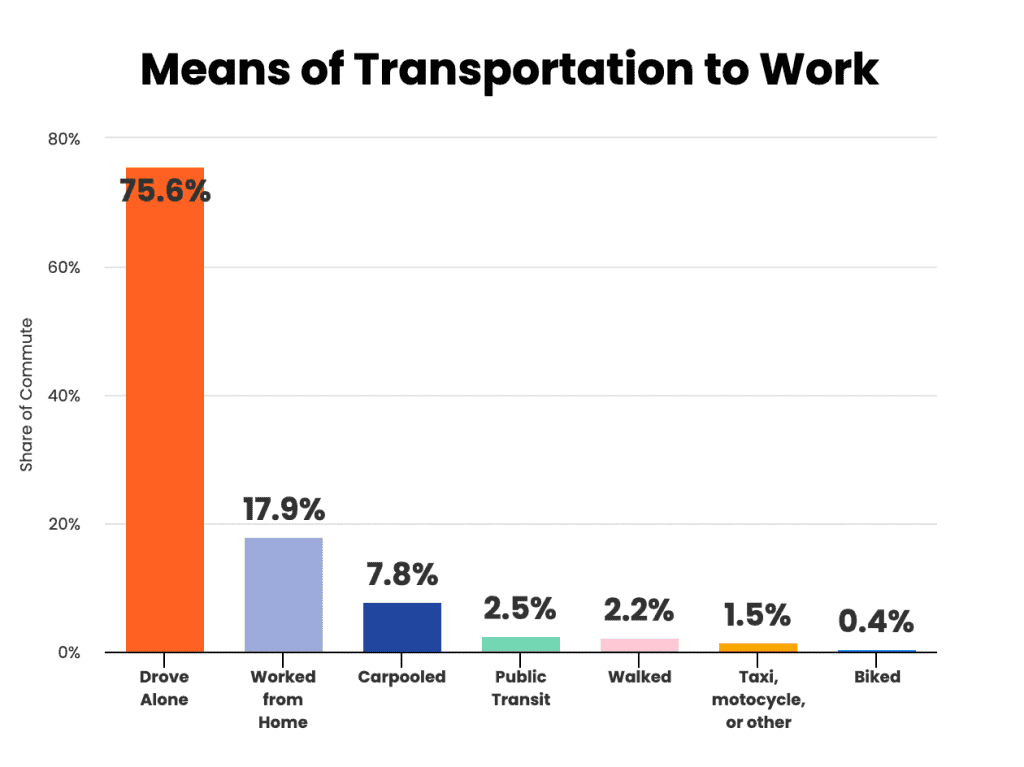Quantifying the carbon impact of jawnt’s commuter benefit usage

How jawnt is decarbonizing the planet by eliminating single-car commutes.
JOHN HOLMES
MAY 16, 2023
Commuting comprises a large portion of greenhouse gas emissions in the U.S. Today, most Americans drive alone to work, which is the most carbon-intensive mode of commuting. Transitioning from single occupancy vehicle trips to less carbon-intensive methods like public transit, biking, and other forms of micromobility is crucial to reducing greenhouse gas emissions in the coming years. jawnt is facilitating this transition by making it easier for employees to switch their commutes from driving to employer-provided commuter benefits.
Commuting is a large source of carbon emissions in the U.S.
According to data from the EPA, 27% of all U.S. greenhouse gas emissions come from transportation, making it the sector with the highest rate of emissions.

Source: U.S. EPA
Individual car use is the primary contributor to these emissions. While the transportation sector includes planes and large freight vehicles like trucks, ships, and trains, 57% of emissions are coming from light duty vehicles like sedans, SUVs, and pickup trucks.

Source: U.S. EPA
Commuting is a growing source of carbon emissions
If private vehicle use is an outsized portion of greenhouse gas emissions from the highest emitting sector, it’s worth taking a look at the most frequent, and often longest recurring trip Americans typically make: their commute.
According to the National Household Travel Survey, which the Federal Highway Administration conducts every 5-10 years, the number of vehicle trips made for the purpose of commuting has steadily increased since 2000. The total number of miles that all vehicles traveled for commuting purposes during that period has also risen.
This trend of increased vehicle miles traveled for commuting has huge climate implications. According to data from the U.S. Census Bureau, more than 3/4 of U.S. commutes are made by individuals driving alone.

Source: U.S. Census Bureau
… and driving alone is the most carbon-intensive way to commute.

Source: U.S. EPA, National Science Foundation
jawnt helps commuters reduce their emissions
A critical component of reducing emissions in the coming years will be shifting people’s commutes away from drive-alone trips. jawnt can help facilitate the transition to lower-emission commutes by offering commuting alternatives as part of an employee benefits package.
Let’s look at how jawnt currently impacts commute emissions in the Philadelphia region by helping employers offer transit passes as an employee benefit.
Calculating jawnt’s current carbon impact
At one large Philadelphia employer, 6,556 employees (and counting) are enrolled in transit benefits through jawnt. We calculated that these individuals, in aggregate, commute a total of 72,225 miles daily to get to work, or a total of 144,450 miles to get to work and back home.

The average fuel efficiency of a U.S. passenger car is 21.3 mpg. If these employees were driving, they would collectively use a total of 6,782 gallons of gas every work day.

Assuming a typical 260 work days in a year, this amounts to nearly two million gallons of gas used every year for commuting. To put it in terms of emissions, that’s the equivalent of 15,670 metric tons of carbon.

Let’s determine how much of those emissions these employees could eliminate by taking public transit. According to the American Public Transportation Association, by switching from a drive-alone car commute to public transit, an individual can save 0.11 metric tons of carbon annually for every mile of their one way commute. For these employees, that adds up to 7,863 metric tons of carbon saved every year.

Realistically, not all employees enrolled in a transit benefits program will take public transit every single commute. But even if 90% of their commutes are taken on transit, they will still collectively save 7,076 metric tons of carbon every year.

That’s a huge amount of carbon saved, simply by making it easier for employees to take public transit instead of driving. 7,076 metric tons of carbon is the equivalent of:
- 94 tanker trucks’ worth of gas
- 39 railcars’ worth of coal
- 16,366 barrels of oil
In terms of carbon sequestration, it’s the equivalent of:
- 117,002 tree seedlings grown for 10 years
- 8,438 acres of US forests in one year
Estimating jawnt’s future impact
Mind you, the figures presented are just for one employer in Philadelphia. jawnt wants to help workers across the U.S. and world switch away from drive-alone commutes. If we assume similar conditions in other urban areas, the potential carbon savings are massive.
There are 66.5 million workers living in urban areas in the U.S. Based on the conditions described above, jawnt could help these workers save a total of 72,071,261 metric tons of carbon annually.

72 million metric tons of carbon is the equivalent of:
- 954,087 tanker trucks’ worth of gas
- 397,344 railcars’ worth of coal
- 166,696,054 barrels of oil
In terms of carbon sequestration, it’s the equivalent of:
- 1,191,704,497 tree seedlings grown for 10 years
- 85,946,253 acres of US forests in one year
Looking globally, there are 316,650,332 workers in urban areas in the 38 member countries of the Organization for Economic Cooperation and Development. With that many employees having access to transit benefits, jawnt could help them save 342,896,884 metric tons of carbon annually.

72 million metric tons of carbon is the equivalent of:
- 4,539,306 tanker trucks’ worth of gas
- 1,890,461 railcars’ worth of coal
- 793,097,783 barrels of oil
In terms of carbon sequestration, it’s the equivalent of:
- 5,669,829,459 tree seedlings grown for 10 years
- 408,910,597 acres of US forests in one year
Decarbonize your commute with jawnt
The overall breakdown of carbon emissions in the U.S. is complex, but emissions from commuting make up a significant portion. Changing Americans’ commute patterns to include fewer single occupancy vehicle trips and more public transit trips is critical if we hope to decarbonize the transportation sector. jawnt helps companies facilitate this transition by making public transit a cheaper, more attractive commuting option for their employees. To learn more about jawnt, visit our website.






